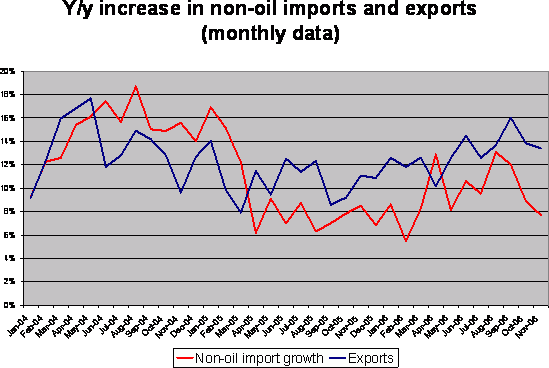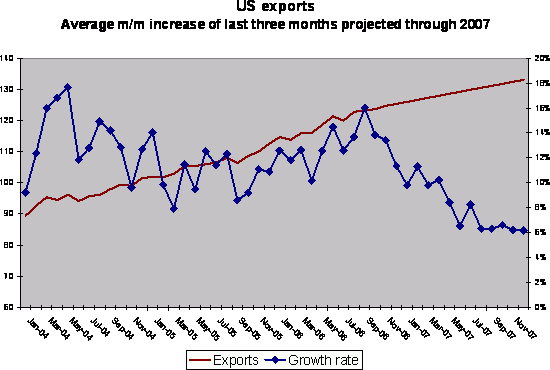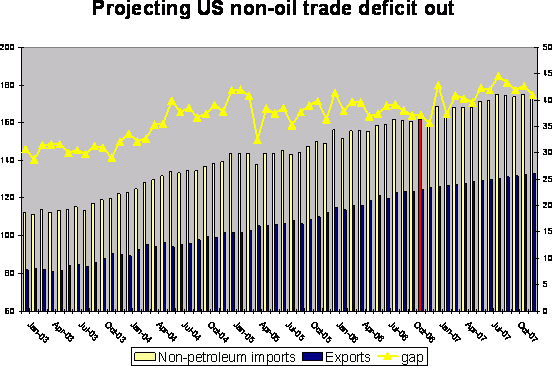The sum of my fears (the future course of the trade deficit)
More on:
As Calculated Risk shows, the US non-oil trade deficit has been flat for sometime now. If you project out a flat non-oil trade deficit and a falling petroleum deficit, the overall deficit should head down. And for that matter, if you can project out recent non-oil import growth (7-8%) and recent export growth (13-14%) and flat oil prices, the trade deficit should head down. David Greelaw (in today's Wall Street Journal) argues: "With each month of data, it's more and more suggestive that the tide has turned."
The following chart shows why the non-oil trade balance has stabilized. Year over year export growth picked up in 2005, while non-oil import growth slowed significantly.

So why am I a bit more pessimistic?
Well, if the US economy avoids a recession, I wouldn’t expect y/y growth in non-oil imports to fall below 7% or so – about where it is now. The recent deceleration came after an acceleration earlier in the year. The fall in the pace of import growth won’t last forever. Not with US imports from China growing at 25% y/y. Lower gas prices may mean more savings -- but they also could mean more money to spend on everything else, including on imports.
And it seems to me like the recent acceleration in the pace of export growth is petering out – after rising from around 10% in 2005 to 14-15% in the summer, the y/y pace of increase now seems to be falling (i.e. the pace of US export growth is decelerating).
That shows up more cleanly if you look at the actual level of exports, not the y/y increase. In the past three months, the average m/m increase in exports has been $0.65 billion. Project that pace of monthly growth out through 2007, and y/y export growth would fall back to around 6% … the blue line in the following graph is the y/y growth rate that corresponds with a $0.65b monthly increase in US exports

If export growth falls back to 6% (nominal) and non-oil import growth stays at 7%, the non-oil trade balance would start to deteriorate again.
The next graph is probably a bit too busy, but it shows monthly (non-oil) imports and export under this scenario. The monthly non-oil trade deficit is on the right hand axis, in bright yellow. The red bar represents that last real data point – everything after that is a projection. The overall non-oil balance has been bouncing around between $35 and $40b a month for some time now – and generally has been on the lower end of that band. The average in 2005 was $38.3b, in 2006 it was $38.5b. That constitutes stability in my book. But in the “slowing export growth” scenario, it rises to above $40b a month.

Is this a plausible scenario if the US economy avoids recession and the global growth remains robust, even if it slows a bit from its current torrid pace?
Possibly. What’s the story?
First, global growth isn’t likely to be stronger in 2007 than it was in 2006, when pretty much all of the world outside the US was growing quite strongly. Europe grew as fast as the US (and faster on a per capita basis), China grew really, really fast (though it relied heavily on exports), Japan grew, all the emerging world grew and so
Second, the lagged impact of the dollar’s big fall v. the euro in 2003 and 2004 may start to dissipate. US firms may have taken as much market share from European firms as they are going to. The dollar is entering into 2007 a quite bit weaker v. the euro than it entered into 2006, but it isn’t weaker than where it was in early 2005.
Moreover the dollar has actually appreciated significantly since 2004 against the yen.
Third, the US may start to hit capacity constraints on the export side. I won’t repost the graph, but exports as a share of US GDP have now rebounded to around 11% of US GDP on the back of recent strong export growth. That is about what they were in 2000. To rise higher – to 12 or 13% of US GDP, the US might need to invest a bit more in additional capacity. And I am not sure the needed investments have been made. Private equity deals to date, to quote breaking views in Wednesday’s Wall Street Journal, have been “exercises in financial engineering.” US business has been more interested in leveraging up existing assets than in investing in new assets.
Boeing has been doing some real engineering, not just financial engineering. But Boeing already exports almost all of its widebody production. The only way its exports can increase is if its production increases. And I doubt that will happen in 2007 on a big scale.
Only 27 767s remain to be built; that line is winding down. The first 787 won’t be delivered before 2008 – and probably the big numbers won’t come until 2009. The goods news is that most 787s will be exported: by my count, US airlines account for about 10% of Boeing’s 787 order book. The bad news is that they won’t be exported in 2007. Boeing will deliver lots of 7s and more 4s than it had any right to expect (thank you Airbus …). I wouldn’t expect Boeing’s exports to increase by another $10b over their 2006 total …
Boeing’s total deliveries rose from under 300 in 2005 to about 400 in 2006, but they aren’t projected to increase at a similar pace in 2007. Obviously, Boeing isn’t the entire US export sector (though it sometimes seems like it), but the Boeing story may be replicated in other parts of the economy. Until more capacity comes on line, it won't be able to export more.
Conversely, I would expect Toyota to import both more Japanese design and engineering (real dark matter, as Toyota's profits don't appear in the US data ...) as well lots of parts and cars. And probably more parts and cars in 2007 than in 2006. Hybrids proved to be kind of popular …
I hope I am wrong on this – and, given how strong global growth is right now, I would be surprised if US export growth really did fall all the way to 6%. Projecting on the basis of a couple of (relatively) slow months is risky. On the other hand, I am not comfortable projecting 13-14% growth out either. Not without a bit more help from America's leading export sector ...
More on:
 Online Store
Online Store
